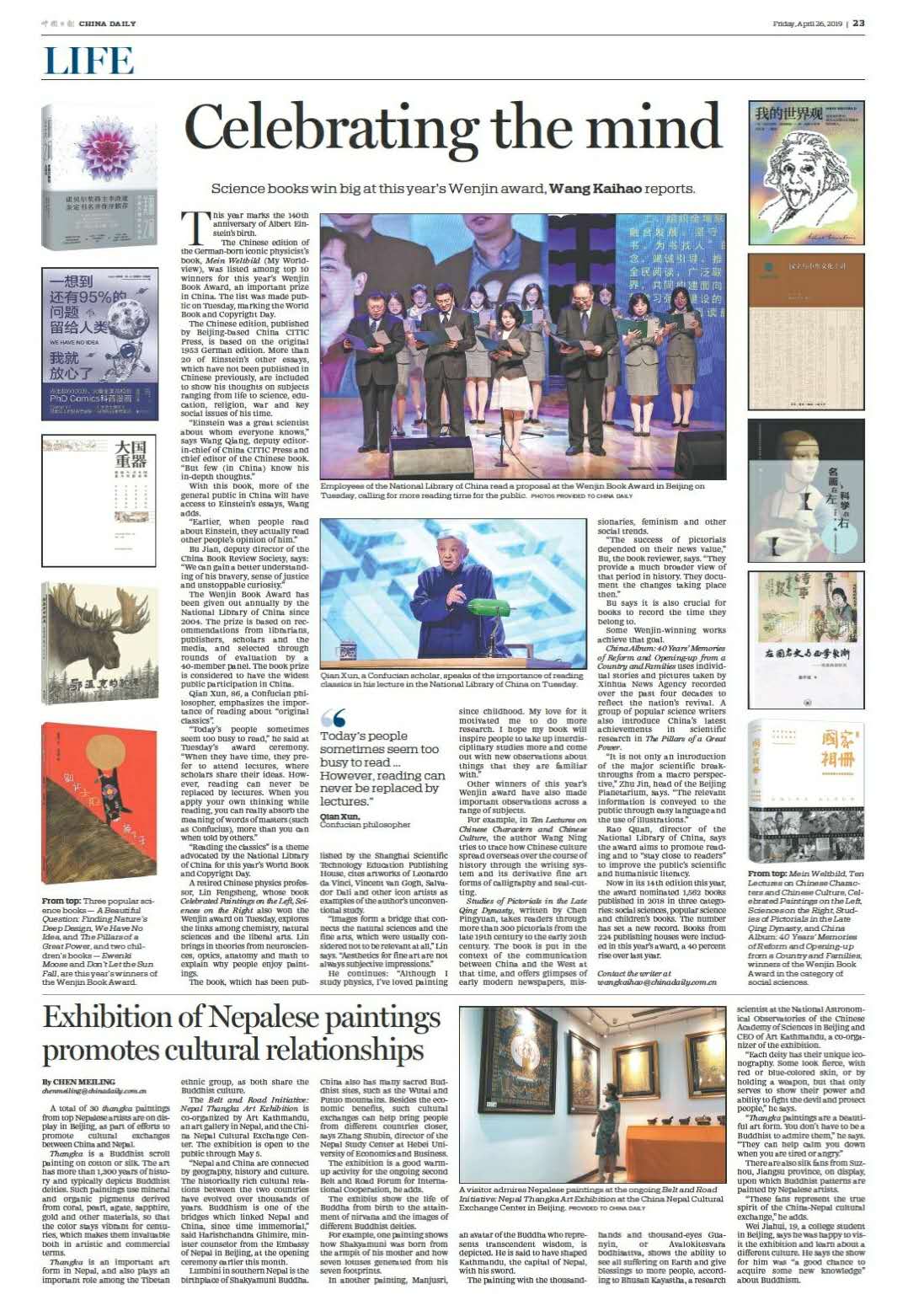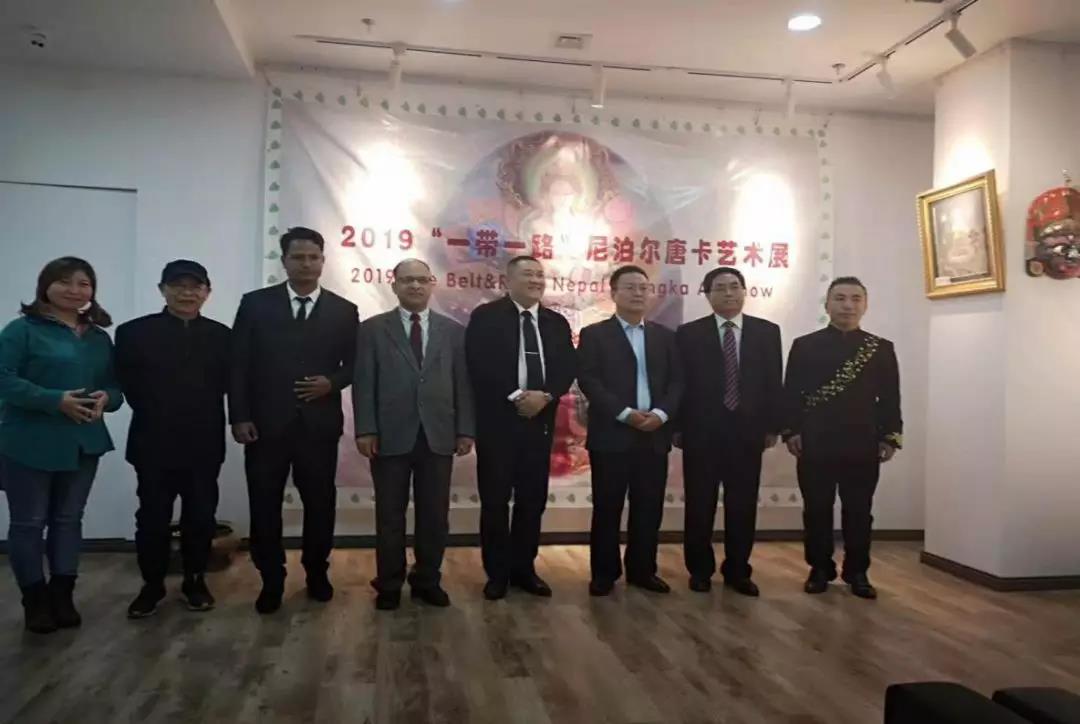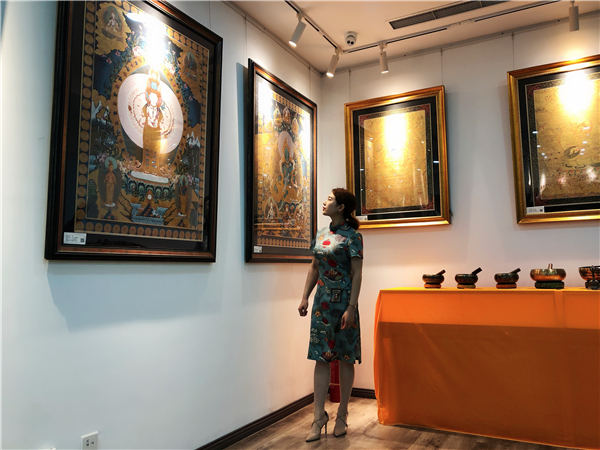2019“一带一路”尼泊尔唐卡展4月13日在北京举行开幕式,《中国日报》记者现场采访了河北经贸大学尼泊尔研究中心主任张树彬教授。随着第二届“一带一路”国际合作高峰论坛开幕式在京举行,《中国日报》4月26日发表特写对张树彬教授的采访予以报道。

图为2019年4月26日中国日报发表的题为Exhibition of Nepalese paintings promotes cultural relationships特写报道

图为2019“一带一路”尼泊尔唐卡艺术展开幕式上嘉宾合影
2019年4月13日,在尼泊尔历2076年新年前夕,2019“一带一路”尼泊尔唐卡艺术展开幕式在北京中尼文化交流中心举行。尼泊尔驻华公使衔参赞哈利斯·昌德拉•吉米瑞(Harish Chandra Ghimire),中国投资协会领导,中尼友好人士和尼泊尔留学生等出席活动。我校尼泊尔研究中心主任张树彬应邀出席开幕式并致辞。
张树彬介绍了河北经贸大学尼泊尔研究中心,以及中国与尼泊尔的历史和现实联系,特别是河北经贸大学承办的加德满都大学孔子学院和中国援助尼泊尔医疗队,他认为中尼两国历史文化渊源深厚,尼泊尔的蓝毗尼是佛祖诞生地,中国也有像五台山和普陀山等佛教圣地。这样的文化交流活动,可以加强一带一路的民心沟通。此次尼泊尔唐卡艺术展也为尼泊尔总统班达里访华并出席第二届“一带一路”国际合作峰会,以及将于五月十八日在北京举办的亚洲文明对话大会,营造了良好的氛围,建议对唐卡上的所绘制的人物故事增添文字介绍,以方便观众通过了解唐卡艺术加强中尼文化交流。
中国日报报道原文:
Exhibition of Nepalese paintings promotes cultural relationships
By ChenMeiling| China Daily | Updated: 2019-04-26 07:10
http://www.chinadaily.com.cn/cndy/2019-04/26/content_37462619.htm

A visitor admires Nepalese paintings at the ongoing Belt and Road Initiative: Nepal Thangka Art Exhibition at the China Nepal Cultural Exchange Center in Beijing. [Photo provided to China Daily]
A total of 30 thangka paintings from top Nepalese artists are on display in Beijing, as part of efforts to promote cultural exchanges between China and Nepal.
Thangka is a Buddhist scroll painting on cotton or silk. The art has more than 1,300 years of history and typically depicts Buddhist deities. Such paintings use mineral and organic pigments derived from coral, pearl, agate, sapphire, gold and other materials, so that the color stays vibrant for centuries, which makes them invaluable both in artistic and commercial terms.
Thangka is an important art form in Nepal, and also plays an important role among the Tibetan ethnic group, as both share the Buddhist culture.
The Belt and Road Initiative: Nepal Thangka Art Exhibition is co-organized by Art Kathmandu, an art gallery in Nepal, and the China Nepal Cultural Exchange Center. The exhibition is open to the public through May 5.
"Nepal and China are connected by geography, history and culture. The historically rich cultural relations between the two countries have evolved over thousands of years. Buddhism is one of the bridges which linked Nepal and China, since time immemorial," said Harishchandra Ghimire, minister counselor from the Embassy of Nepal in Beijing, at the opening ceremony earlier this month.
Lumbini in southern Nepal is the birthplace of Shakyamuni Buddha. China also has many sacred Buddhist sites, such as the Wutai andPutuomountains. Besides the economic benefits, such cultural exchanges can help bring people from different countries closer, says Zhang Shubin, director of the Nepal Study Center at Hebei University of Economics and Business.
The exhibition is a good warmup activity for the ongoing second Belt and Road Forum for International Cooperation, he adds.
The exhibits show the life of Buddha from birth to the attainment of nirvana and the images of different Buddhist deities.
For example, one painting shows how Shakyamuni was born from the armpit of his mother and how seven lotuses generated from his seven footprints.
In another painting,Manjusri, an avatar of the Buddha who represents transcendent wisdom, is depicted. He is said to have shaped Kathmandu, the capital of Nepal, with his sword.
The painting with the thousand-hands and thousand-eyes Guanyin, orAvalokitesvarabodhisattva, shows the ability to see all suffering on Earth and give blessings to more people, according toBhusanKayastha, a research scientist at the National Astronomical Observatories of the Chinese Academy of Sciences in Beijing and CEO of Art Kathmandu, a co-organizer of the exhibition.
"Each deity has their unique iconography. Some look fierce, with red or blue-colored skin, or by holding a weapon, but that only serves to show their power and ability to fight the devil and protect people," he says.
"Thangka paintings are a beautiful art form. You don't have to be a Buddhist to admire them," he says. "They can help calm you down when you are tired or angry."
There are also silk fans from Suzhou, Jiangsu province, on display, upon which Buddhist patterns are painted by Nepalese artists.
"These fans represent the true spirit of the China-Nepal cultural exchange," he adds.
WeiJiahui, 19, a college student in Beijing, says he was happy to visit the exhibition and learn about a different culture. He says the show for him was "a good chance to acquire some new knowledge" about Buddhism.